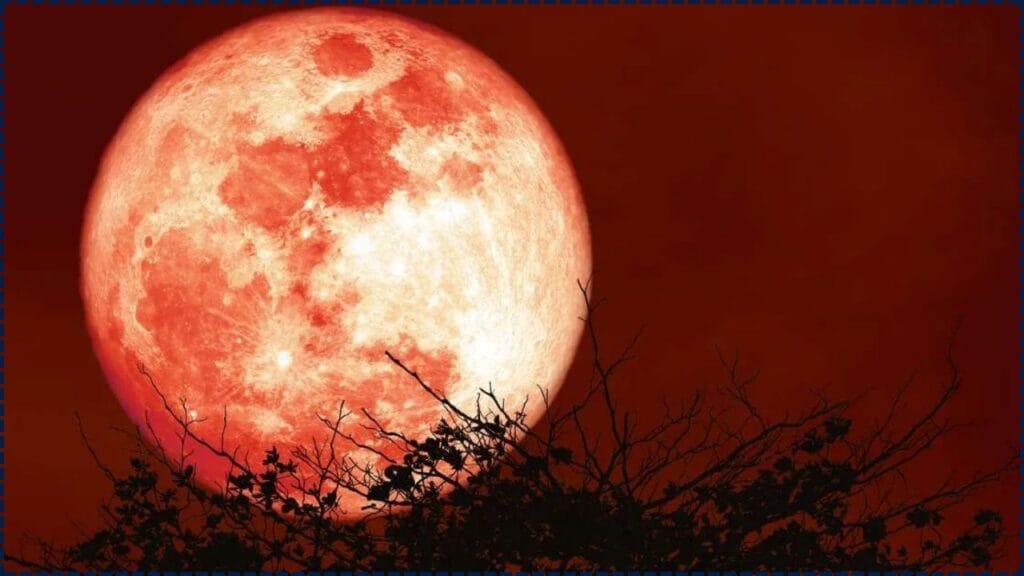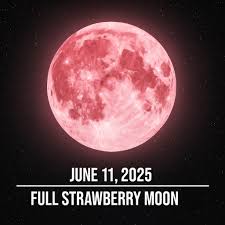As June 2025 approaches, the Strawberry Moon invites skywatchers, dreamers, and families to pause and gaze upward, uniting us in the gentle glow of a celestial event that promises to touch hearts across the globe. This isn’t just a full moon—it’s a breathtaking moment that breaks an 18.6-year record as the lowest full moon in the sky, a rare gift from the cosmos that calls us to come together and celebrate the beauty of our shared world.

Thanks to the lunar nodal cycle, a delicate dance of orbits, the 2025 Strawberry Moon will hover close to the horizon, creating a stunning, intimate view that feels like nature’s embrace. More than a visual wonder, this moon carries centuries of cultural meaning, from Indigenous traditions honoring the ripening of strawberries to modern communities finding solace in its glow. It’s a moment to slow down, reconnect with loved ones, and rediscover our bond with the Earth and sky. Whether you’re a stargazer or simply someone seeking peace.
Strawberry Moon 2025
| Feature | Details |
|---|---|
| Full Moon Name | Strawberry Moon |
| Date of Peak Illumination | June 11, 2025, at 3:44 a.m. EDT |
| Record Broken | Lowest full moon in 18.6 years |
| Best Viewing Time | Moonrise on June 10 (evening) |
| Moon Appearance | Golden hue, large on the horizon |
| Cultural Origins | Named by Algonquin and other Native American tribes |
| Source | Star Walk, Farmers’ Almanac |
The Strawberry Moon 2025 is more than a celestial event — it’s a moment to reconnect with history, nature, and wonder. With roots in Native American tradition, scientific significance, and visual splendor, this moonrise offers something for everyone.
Whether you’re snapping photos for Instagram, teaching your kids about space, or just taking a deep breath beneath the stars, the Strawberry Moon invites you to slow down, look up, and remember your place in the universe.
Mark your calendar. Charge your camera. And prepare to be amazed. You won’t get another moon like this until 2043.
What Is the Strawberry Moon?
Native American Roots and Modern Meaning
The Strawberry Moon, named with love by Indigenous tribes like the Algonquin, Ojibwe, and Dakota, carries a legacy of wisdom and unity. Guided by the lunar cycle, these communities looked to the sky to mark the precious season when wild strawberries ripened, a time to gather and share nature’s bounty. Without modern tools, they relied on the gentle rhythms of the Earth and sky, weaving a deep bond between people and the land that sustained them.
This moon was more than a marker—it was a call to come together, to nurture community, and to honor the gifts of the Earth. These traditional names, rich with meaning, were vital threads in the tapestry of survival and togetherness, reminding us of the strength found in unity. Today, the Strawberry Moon invites us all—skywatchers, families, and dreamers—to pause, reflect, and reconnect with the Earth’s rhythms. It’s a moment to celebrate our shared roots, embrace the wisdom of those who came before us, and foster a caring, collective appreciation for the beauty and soul of our planet’s skies.
No, It’s Not Actually Pink
Despite the sweet-sounding name, the Strawberry Moon doesn’t shine pink or red. Instead, it usually takes on a rich golden or amber hue, especially during moonrise or moonset. This color change is due to the scattering of light as it travels through the thicker layer of Earth’s atmosphere near the horizon.
Think of those breathtaking sunsets — the same physics apply here. The result? A warm-toned moon that looks like it’s been dipped in honey. Some even say it’s the most Instagrammable moon of the year.
What Makes the 2025 Strawberry Moon So Special?
Breaking a Nearly 20-Year Record
The 2025 Strawberry Moon, glowing in June’s night sky, is a rare and precious moment that invites people everywhere to come together in wonder and gratitude. Thanks to the gentle rhythm of the 18.6-year lunar nodal cycle, this full moon will grace the horizon at its lowest point since 2007, a breathtaking celestial event that feels like a warm embrace from the cosmos. This unique alignment, shifting the moon’s path relative to Earth, offers a shared experience that connects families, communities, and dreamers under the same starry sky.
This extraordinary low moonrise, a sight not to be seen again until 2043, is a gentle reminder to pause and cherish the fleeting beauty of our world. It’s an opportunity for neighbors to gather, for children to gaze in awe, and for all of us to reflect on our place in the universe.
Optical Illusion = Bigger Moon
Have you ever noticed that the moon looks gigantic when it’s near the horizon? That’s called the moon illusion — a psychological trick where our brains perceive the moon as larger when it’s near familiar objects like trees, buildings, or hills.
Combine that illusion with the actual low altitude and dramatic lighting, and this moon will look massive and cinematic — a moment straight out of a movie. In fact, this moonrise is a favorite of night photographers and astro-artists looking to capture that epic shot.

Best Time and Places to View It
When Should You Watch?
Although the moon reaches its technical peak at 3:44 a.m. EDT on June 11, the most stunning time to see it is moonrise on the evening of June 10. That’s when it’ll be low, glowing, and playing tricks on your perception.
Depending on your location, moonrise typically happens just after sunset. Use a tool like Time and Date or the US Naval Observatory to plug in your zip code and get exact times.
Where’s the Best Spot?
Look for a place with a wide-open view of the southeastern horizon. Ideal spots include:
- Beaches with open sky views
- Open fields or farmland
- Hilltops or elevated trails
- Rooftops or decks in urban areas
- City parks with minimal tree obstruction
Avoid areas with lots of tall trees or buildings. Bring a blanket or lawn chair, and if you’re in the mood, make it a mini event with friends or family.
Practical Tips for Viewing and Photography
- Use Binoculars or a Small Telescope: Even a cheap pair of binoculars can enhance your view. You’ll see craters, ridges, and maybe even some color variation across the moon’s surface. A small telescope takes it to the next level.
- Bring Your Camera or Phone: Modern smartphones with night mode can capture amazing shots — especially if you stabilize your phone. Use a tripod or set your device on a flat surface. For serious photographers, manual camera settings and longer exposures will create unforgettable lunar portraits.
- Set the Mood and Make It Fun: Bring some camp chairs, a cozy blanket, and maybe even snacks or hot cocoa. Make it a lunar picnic! Stargazing is more fun when it feels like a mini celebration.
- Check Weather and Light Pollution: Use apps like AccuWeather to confirm a clear sky. If you’re in a city with heavy light pollution, consider heading somewhere darker for a clearer view.
Cultural and Historical Significance
Why Moon Names Matter
In Indigenous traditions, each full moon had a name tied to seasonal events. The Strawberry Moon indicated the time to harvest berries — a vital food source for many tribes. These names weren’t just folklore — they were community calendars rooted in deep ecological knowledge.
In Europe, this moon was known as the Mead Moon or Honey Moon, often linked to fertility rituals and June weddings. In fact, many historians believe the term “honeymoon” comes from this time of year, when newlyweds drank honey mead to bring good fortune.
Influence on Modern Culture
Today, the Strawberry Moon continues to inspire artists, musicians, poets, and spiritual practitioners. It’s celebrated in lunar circles, yoga events, and even school science nights. Whether it’s ritual or recreation, the moon keeps us connected — to the past, to each other, and to the planet.
Related Links
8 Proven Strategies to Stay Financially Afloat When Times Get Tough
The Smart Investor’s Playbook: 3 Vanguard ETFs to Anchor Your Long-Term Portfolio
The Truth About Tariffs and the U.S. Trade Deficit — Are We Heading Toward a Crisis?
What Scientists Say
Scientists love full moons, especially when they bring unique alignments like this one. Observatories around the world will be collecting data on the lunar position, atmospheric effects, and surface reflectivity.
The moon’s gravitational pull impacts more than just the tides. Some studies suggest it influences animal behavior, plant growth, and even human sleep cycles. Full moons also provide perfect conditions for calibrating space instruments used in satellites and telescopes.
FAQs
What date is the Strawberry Moon in 2025?
It peaks early on June 11, 2025, at 3:44 a.m. EDT. But the best visual experience happens during moonrise on June 10.
Will it look red or pink?
Nope, not really. It’ll appear golden to orange due to the way light bends through our atmosphere near the horizon.
Is this the lowest full moon of the year?
Yes! In fact, it’s the lowest full moon we’ll see for nearly two decades — a result of the 18.6-year lunar nodal cycle.
Can I see it without any special equipment?
Absolutely. No gear needed — just your eyes, a clear sky, and maybe some friends to enjoy it with.
Why is it called the Strawberry Moon?
It’s named after the short-lived strawberry harvest season, particularly noted by Native American tribes like the Algonquin.








